Top Great Wall Sections
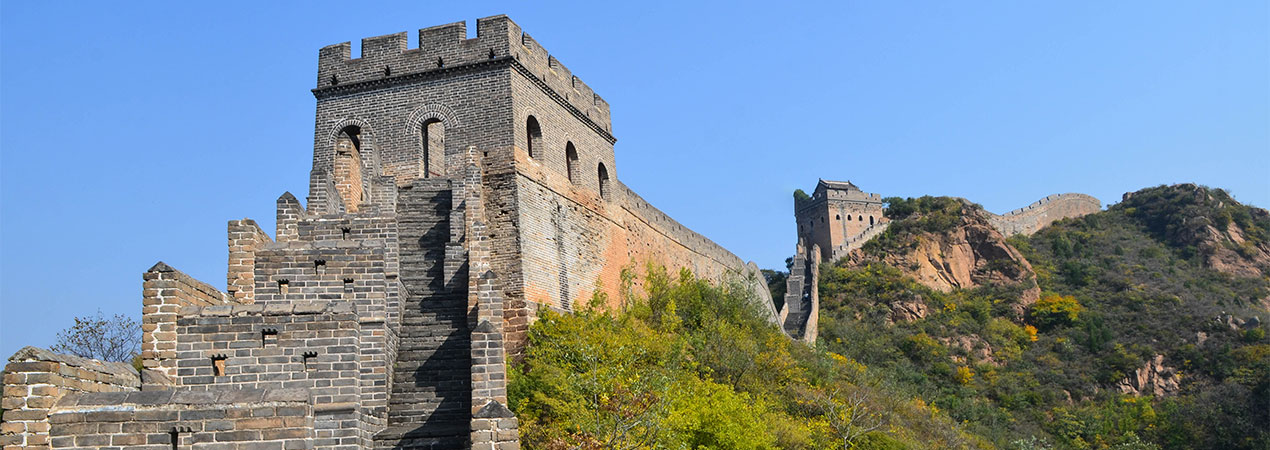
Sections of the Great Wall in Beijing: A Quick Comparison
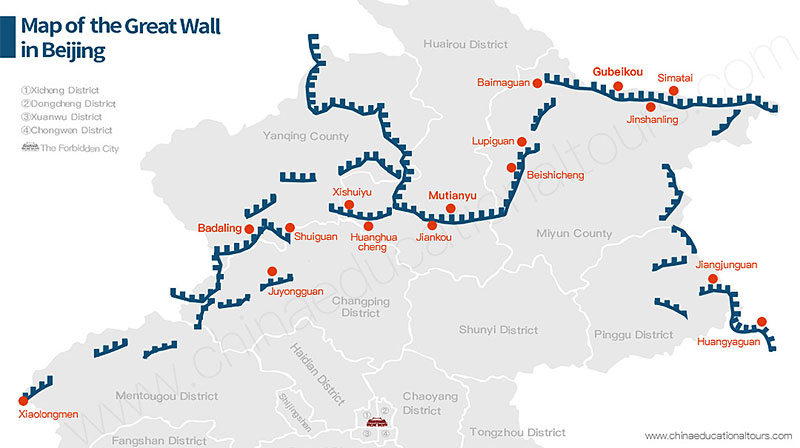
Map of the Great Wall in Beijing
| Section | Features | Facilities | Driving hours from downtown Beijing with CET | Activities | Recommended tour time | Physical demands (out of 5) | Crowds (out of 5) | Tourist development | Fit for |
|---|---|---|---|---|---|---|---|---|---|
| Mutianyu | Uniquely designed marathon site | Shuttle bus, cable cars up/down and option of tobogganing down | 1½ | Tobogganing down, hiking, sightseeing, photography | Half-day to a day |  |
 |
Fully restored | Ordinary visitors |
| Jinshanling | Quiet with amazing view, marathon site | Cable cars | 2 | Hiking, photography | A day |  |
 |
Partially restored with wild | Ordinary visitors |
| Simatai | Connected with a water town, rich activities | Luggage depository, Wheelchair, Crutches, baby carriage, Children recreation zone; cable cars; battery carts; boats, helicopter, hot-air balloon | 2 | Hiking, night tour, star observation, camping, take helicopter for sightseeing, high-altitude hot-air balloon ride, boats on the reservoir up to the East Tower | A day |  |
 |
Fully restored | Ordinary hikers |
| Jiankou | Really steep, with mountain ridges in the shape of a "W" | None | 2½ | Hiking, camping, photography | A day to two days |  |
 |
Mostly wild | Strong hikers |
| Huanghuacheng | Some parts in water | Boats | 1½ | Camping, boating, hiking, photography | A day to two days |  |
 |
Mostly restored | Ordinary hikers |
| Gubeikou | Original site | None | 2 | Hiking, photography | A day |  |
 |
Mostly wild | Ordinary hikers |
| Juyong Pass | Fabulous vistas, architecture with engraving | Some wheelchair access, crutches, baby carriage | 1½ | Hiking | 2 hours |  |
 |
Fully restored | All visitors (wheelchair- friendly) |
| Huangya Pass | Marathon site | Wheelchair, Crutches, baby carriage, Several eco-friendly toilets set up along this section | 2½ | Marathon, sightseeing | A day |  |
 |
Mostly restored | All visitors |
| Badaling | The most famous | Cable cars; Great Wall Museum; circular-screen cinema, English Electronic tour guide service | 1½ | Hiking | Half-day to a day |  |
 |
Fully restored | All visitors (wheelchair- friendly) |
#1 Jiankou (Arrow Nock)
Location: Beijing
The Construction Time: Ming Dynasty(1368AD-1644AD)
Key Words: The steepest part of the Great Wall, with no artificial modifications, the best for hikers and photographers.
Length: 20km
The Reason it is listed here:
Jiankou Great Wall was named for its W shape which resembles a bow and the low point of it which looks like the notch in the butt end of an arrow (the nock). With severe natural weathering, it is the steepest and most magnificent section of The Great Wall located in Beijing. It has become a highly recommended spot for hikers and photographers for its wildness and lack of any artificial renovations. From the Ox Horn Edge, to the Big South Tower, the Gate of Hell, the Transmeridional Short Neck Tower, the Transmeridional Oil Basket Tower, the Arrow Nock, the General Tower, the Sky Stair, the Eagle Flies Facing Upward and finally the Nine-eye Tower, it runs for a length of 20km. It is a masterpiece by mankind of ancient times. You will experience the original landscape of the Great Wall as you visit it. If you are lucky enough, clouds that look like the waves on the sea will appear overhead. More Travel Tips »
#2 Mutianyu
Location: Beijing
The Construction Time: Founded in the Northern Qi Dynasty (550AD -577AD), rebuilt in 1368AD.
Key Words: Protect the Ming Tombs, suitable for year-round visit.
Length: 5.4km
The Reason it is listed here:
- The scenic spot is lush and covered with trees, more than 96% of the area is covered by vegetation.
- It’s peculiar. Different from other parts of the Wall, Mutianyu has water towers which are built in a unique style.
- The number of watchtowers. It is unusual to have a watchtower built every hundred meters.
- It has double crenels on both sides. (Crenels are the indentations in the battlements allowing soldiers to fire on attackers.) While other sections of the Great Wall have one crenel facing outside, Mutianyu section has crenels on both sides. The Wall provided protective cover for guards during the war. With the double crenel, they could fight with enemies on both sides. Mutianyu Great Wall was of strategic importance through history.
- It is joined by a branch wall inside and out. The branch wall was built along the mountain on the side of the main wall in case of war. The outside section of Mutianyu is the branch wall that connects with the No.11 Watchtower. The place where the inside section ends quite suddenly is known as the “Bald Tail Edge”.
- The Great Wall includes a great variety of heights and widths. The Mutianyu Pass’ s terrain is the lowest at only 486 meters above sea level. Further east the wall rises up to 117 meters, where it is less than 500 meters from the Big Turret (No.1 Watchtower).
#3 Jinshanling
Location: Beijing and Hebei
The Construction Time: 1567-1582AD
Key Words: A haven for photographers
Length: 10.5km
The Reason it is listed here:
Jinshanling is known for its broad field of vision, large number of watchtowers placed close together, unique landscape, exquisite building style, sound system of military defense and being well-protected. It is famous as people say, “Jinshaling outshines every other part of the Great Wall”, and it is rated as the best section of the Great Wall. When you visit the Jinshanling Great Wall, it feels like you are stepping into a long corridor inside an ancient building. It is an amazing combination of unrivalled construction work full of the beauty of ethnic art. With attentive observation, we can find there is a varied pattern in the numbers of loopholes, vantage points and the hole that was used for water spitting. These patterns include peach shape, arrow shape, hilt shape, cirrus uncinus cloud shape (comma-shaped), saw-tooth shape, funnel shape, and so on. Every little pattern is exquisite and meaningful. The hundreds of watchtowers in the Great Wall have varied and peculiar shapes. The towers are of different shapes; there are square, round, rectangular, and octagonal towers. Roofs are also of different shapes; some are flat-roofed, domed, have awnings or shapes like four horns to the sky, and some have an eight-horned shape. Also some watchtowers have a strange frame. Some cornices are sculptured to resemble a variety of flowers or animals. All of these constitute a wonderful landscape that attracts photographers from all over the world. More Travel Tips »
#4 Simatai
Location: Beijing
The Construction Time: Ming Dynasty, 1568 AD
Key Words: The only section that completely retains the Ming Great Wall’s original appearance. (This means it was accurately repaired according to the original style of the Great Wall, while other sections of the Great Wall include modern architectural elements after being repaired.)
Length: 5.4km
The Reason it is listed here:
- Simatai is the only section that has well retained the original appearance of the Ming Great Wall.
- Precipitous because it was built on the sliced ridge so that it is dangerous but challenging;
- The watch towers are so close to each other. The nearest ones are a few meters apart and the farthest are no more than 300 meters, the average spacing is only 140 meters;
- Unique for its steep terrain and magnificent landscape. As well as all this the scenery includes the Mandarin Ducks Lake (fed by a cold spring and a hot spring) where the ripples always appear green;
- Artistically pleasing for its pass wall which was skillfully constructed step-by-step, and which can be used defensively by guards when under attack;
- All-inclusive for its peculiar and various architectural styles of the gate towers and watchtowers.
- The Simatai Great Wall is known for being precipitous, dense, unique, artistically pleasing, and all-inclusive.
#5 Badaling
Location: Beijing
The Construction Time: 1505AD
Key Words: The earliest Ming Great Wall opening to tourists, and attracts the most famous people.
Length: 7.4km
The Reason it is listed here:
Badaling Great Wall is the best preserved and most representative section of Ming Great Wall. It is the essencial section of the Ming Great Wall and the outpost of Juyong Pass which is the most vital pass of the Great Wall. Being up to 1015 meters above sea level, it had a strategic geographical location and protected the capital very well. As the essence and the outstanding delegate of Great Wall, Badaling was known as one of the Nine Forts under Heaven in ancient times. It was also the first section of The Great Wall to be opened to visitors.
Other than the Wall itself, there are other attractions such as Great Wall Steles (monuments), Five-men’s Statue, Stone Statue of Stone Buddha temple, Goldfish Pond, Crossroad, Qijiguang Garden, Yuanchonghuan Garden, Great Wall Stele Garden and The Ancient City of Crossroad. Badaling Great Wall is now a complex scenic spot, consisting of 3 parts. The main part is made of the opening section of Great Wall, China Great Wall Museum and Great Wall Cinema. The second part is composed of three free gardens. The third part includes two affiliated spots, remnant Great Wall and The Ancient City of Crossroad. More than 500 heads of state, chiefs of governments and leaders of ruling parties have been to Badaling Great Wall up until 2009, such as President Reagan, Mrs. Thatcher and so on.
More Travel Tips »#6 Huangyaguan
Location: Beijing, Hebei
The Construction Time: 556AD
Length: 42km
Key Words: The first Great Wall Museum
The Reason it is listed here:
Located in the mountains about 30km to the north of Jixian County, Tianjin City, the Huangyaguan Great Wall was firstly built in 556AD. Qijiguang, the famous general of the Ming Dynasty, had redesigned and overhauled Huangyaguan when he was the Chief General of Jixian County. The architectural characteristic of this section are that the wall is made of bricks and stones, the watchtowers are round or rectangular using both hollow and solid bricks. Passes, walls, forts, blockhouses, watchtowers and Water Pass can all be found here. It can even be confirmed that it has every sort of architecture in it. Connected to the mountain and across the river, the layout is gorgeous, precipitous, unique and lovely rolled up into one. Here is the first Great Wall Museum and a collection of modern Great Wall Steles (monuments).
Great Wall Museum
The first Great Wall Museum of China is the Huangyaguan Great Wall Museum in Tianjin, which is close to the Jixian Ancient Great Wall in Tianjin. This 41 kilometer-long ancient Great Wall was built in AD 577, and is located in the area of Huangyaguan that is about 30km to the north of Jixian County. During the Longqing Period in the Ming Dynasty, the national hero Qijiguang acted as the chief general of Jixian County. In order to strengthen the south border, he had decided to redesign and overhaul on the base of the original Great Wall of this section. The renovated Great Wall stretches from Banlagang Mountain in the east to Wangmaojing Mountain in the west. There are stone walls of the Northern Qi Dynasty and brick walls of Ming Dynasty in the Great Wall. The watchtowers are of various shapes, different materials and types, such as round and square, stones and bricks, hollow and solid. There are sentry towers built outside the wall and abutments set inside the wall independently. In the museum, you can study materials of the ancient Great Wall of China, Jixian Ancient Great Wall, the sabre that Qijiguang used, weapons and life products of frontier soldiers and other cultural treasures which are on display.
More Travel Tips »#7 Juyongguan
Location: Beijing
The Construction Time:1505AD
Length: 4km
Key Words: The north gate of Beijing, rich with vegetation
The Reason it is listed here:
Juyong Pass is known as the First Pass under the heaven; it is the pass that lies along the Northern Great Wall, located in the area about 10km south of the Badaling Great Wall. The existing Juyong Pass was built in the Ming Dynasty but fell into disuse gradually in the late Qing Dynasty, and the Gate Tower and other historic sites were repaired later on. Juyonguan Great Wall has precipitous topography and attractive scenery. The most famous scenic spot of Juyongguan Great Wall is Yuntai. It is the base of a huge lamaist pagoda Tower of Yuan Dynasty, and also the earliest and biggest over-street construction existing in China. Lingering here can make you feel the desolation, peace and 2000 years of history.
Architectural features
- It is a circular enclosed building.
- There is a large variation of width and height. The widest is 16.7 meters wide while the narrowest is only 1.2 meters. The Dongshan Great Wall is 370 meters higher than Hetao Great Wall. Its wall is low inside and is called the Parapets or Yu wall and high outside which is called the Crenel Wall. Such a design would stand up against the enemy effectively.
- It has various architectural structures. It includes the essence of the whole Great Wall. When cleaning up the base, people found that the wall was made up of granite, squared stones, chippings, and bricks. Therefore, its varying ages of architecture can be inferred from the materials in the wall.
- It has a wide military defense scope. The whole area covers 50 hectares, with 1150 meters’ distance between the eastern peak and the western one. The defense projects include the northern and southern walls, the water tower, the water gate, the sluice, the watchtower, the cabin, the beacon tower, the turret and the battery.
#8 Jiayu Pass
Location: Gansu
The Construction Time:1372AD
Length:733m
Key Words: The starting point at the eastern end
The Reason it is listed here:
Natural Museum of the Great Wall, Jiayuguan Great Wall, the top mound of the Great Wall. the Hanging Great Wall and the Han and Ming Great Wall that can be seen on the Gobi Desert, all these precious Great Wall ruins and relics put together form a timeline of Chinese history and civilization.
500 meters to the west of the Wall’s top mound, looking down along the Valley of Taolai River, you will find it becomes clear all of a sudden right in front of you. Here the flags are fluttering, and an ancient barrack ishidden. Only by stepping into it then looking back can visitors find that there is a half-opened underground cavern in the middle of Taolai River valley, which is about 200 meters away from the top mound. The Shiguan Valley Hanging Great Wall is located 14 km northwest of Jiayuguan City and 8.4km from the Jiayu Pass. It displays the culture of the old Silk Road and Great Wall.
(P.S. The Top Mound and Hanging Great Wall are respectively 7.5km and 8.4km apart from Jiayu Pass.)
More Travel Tips »#9 Zhao Great Wall
Location: Yinshan, Baotou City
The Constrution Time: 306BC -300BC
Length: 400m
Key Words: The earliest Great Wall.
The Reason it is listed here:
Located among the peaks and hills of the southern Yinshan, Zhao Great Wall was a significant military base in ancient times. It was built through the mountains with a mixture of soil and stone. Stretching about 400 meters, most sections have collapsed and been rebuilt with stones for the outer, and soil and rubble for inside. Some better preserved sections are 1.5 meters high, 2.5 meters wide on the bottom and 1 meter wide on the top, so the cross section presents a trapezoid shape. But most sections were presented in a ridge shape, and several sections were hard to find.
Standing on this well-preserved section of the soil-made Great Wall, we can faintly see these historical sites stretching from the Big Temple, east to the Hao Village of sidewall, west to the Kun District. The ruins of the Zhao Great Wall and the relic of the beacon tower can be still seen clearly from a distance. This section of Great Wall was made of layers of soil, and the remaining base of it is about 3.5 to 4 meters wide and 1 to 1.8 meters high. Among the Great Wall’s relics, there may be found many potsherds of the Warring States period, and some specimens like half coins, flat tiles, terrines, bowls and copper chains. All these valuable materials were left for study so we can understand history, and be educated about ancient life.
#10 Hushan Great Wall
Location: Dandong, Liaoning
The Construction Time: 1250AD
Length: 1250m
Key Words: The easternmost reaches of Great Wall
The Reason it is listed here:
The Hushan Great Wall was built during the Chenghua Period of Ming Dynasty (AD 1469) to defend against intrusions from Nuchen. But after Nurhachi became the emperor, he issued a decree that the people of the Shanhaiguan were not allowed to go outside the area to ensure stability and development of this region. The people inland were not allowed to cultivate or hunt within the scope of Manchu’s birthplace. However, through several years, Hushan Great Wall almost fell into oblivion so that for ages people mistakenly thought that the eastern end of Great Wall was the First Pass under Heaven, Shanhaiguan. In fact, as recorded in the The Military History of Ming, “Before the Ming, cautious border, east from Yalu River, west to Jiayuguan.”, and it was made clear that Great Wall “stretched east from Yalu River and west to Jiayuguan.”.
Now the renovated part of Hushan Great Wall is more than 1250 meters long, with street-wide building, beacon towers, enemy towers, battle towers and bastions. The magnificent design of the Ming Great Wall can be rediscovered. It takes advantage of the location along the hillside, winds to the north, close to Dandong City and facing North Korea across Yalu river. It is the Great Wall of beautiful mountains, clear rivers, pleasant weather and breathtaking views.
Other Popular Sections
#Gubeikou
Location: Miyun District, Beijing
The Construction Time: 555 CE
Key Words: The oldest part of the Great Wall in Beijing retains the most original features
Length: 3 miles (5 km)
The Reason it is listed here:
This section of the Great Wall has not been reconstructed since the Ming Dynasty, and numerous watch towers and beacon towers have remained despite the fact that more than a thousand years have passed by. At the highest point, the General Tower affords the best field of view of the entire Great Wall. You can seize the opportunity to take a great shot of the panorama. Avoiding the crowded sections and the reconstructions, you will hike in peace with magnificent views of the wall zigzagging across the ridges, and enjoy the atmosphere of profound Chinese history. Finally, visit the unique 24-eye tower, a particular building on the Great Wall which cannot be found on other sections.
#Huanghuacheng
Location: Huairou District, Beijing
The Construction Time: 1404-1592CE
Key Words: the wild Great Wall has a partial segment submerged in the water, with impressive views and a steep climb
Length: 7.7 miles (12.4 km)
The Reason it is listed here:
Huanghuacheng is the only waterside section in Beijing, which combines mountains, clear water and the Great Wall. This area is colored by yellow flowers in summer and colorful leaves in autumn, hence the name Huanghuacheng Great Wall (‘huanghua’ in Chinese means yellow flowers). There are lush flowers in three season of a year, peach and apricot flowers in spring, chestnut flowers in summer, and plum blossoms in winter.
It is a great destination for hiking to meet the various needs of visitors. The tour can be connected to hiking, boating, and amazing sightseeing without crowds. All of these make this section favored by nature lovers.

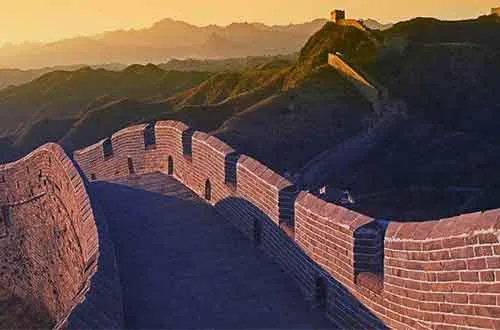 Top 10 Facts about the Great Wall
Top 10 Facts about the Great Wall 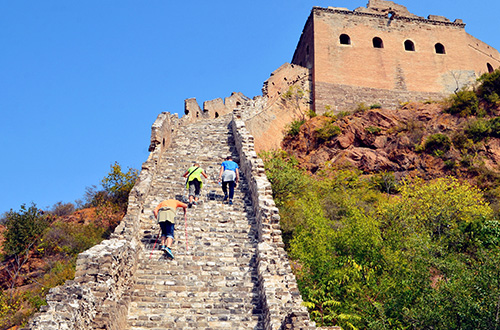 Hike on the Great Wall
Hike on the Great Wall 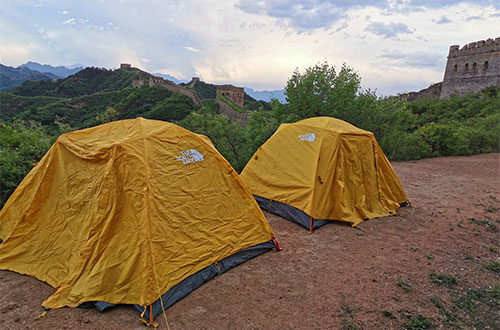 Camping on the Great Wall
Camping on the Great Wall 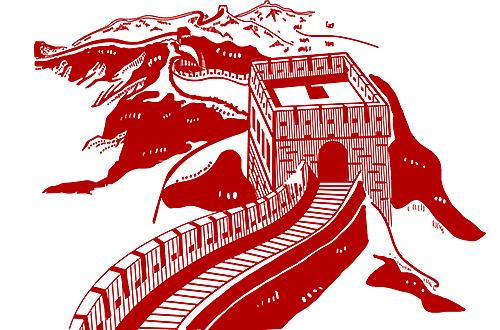 2 Poems about the Great Wall
2 Poems about the Great Wall